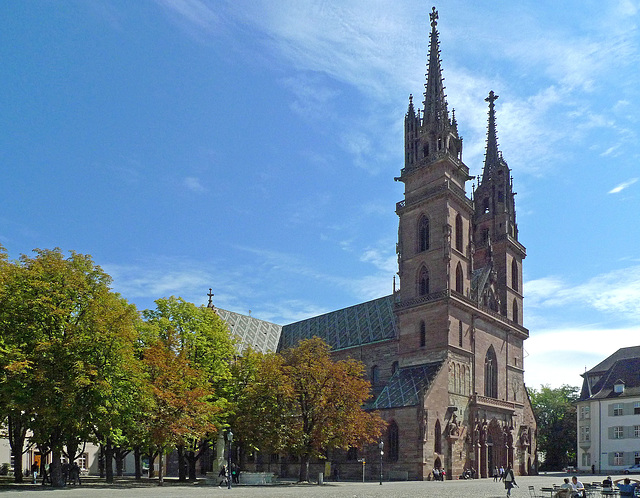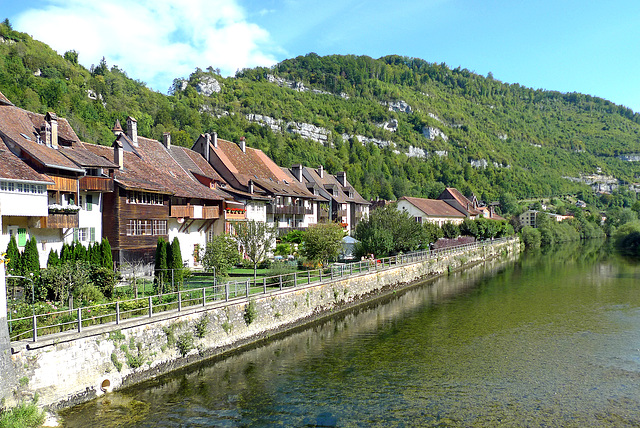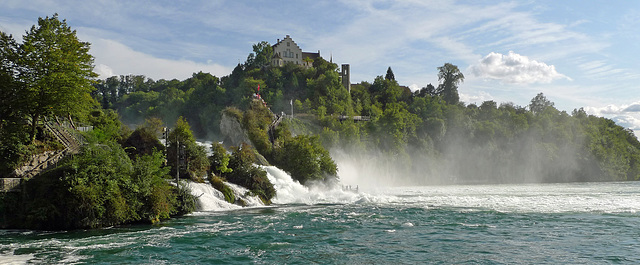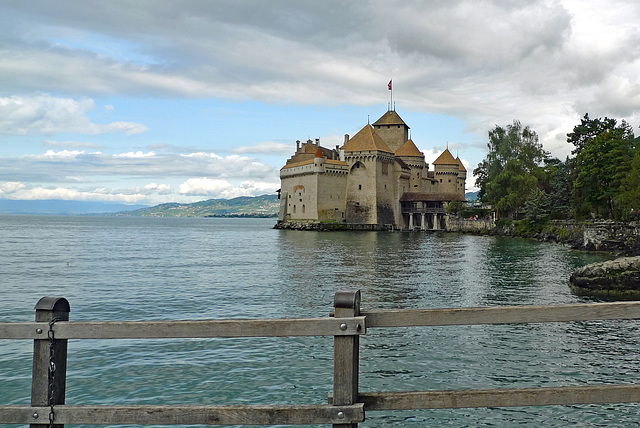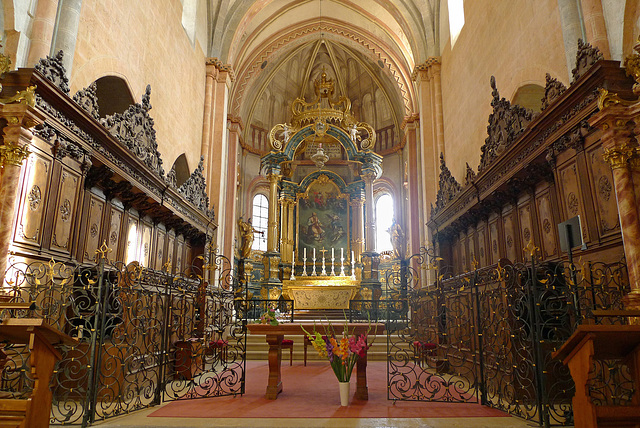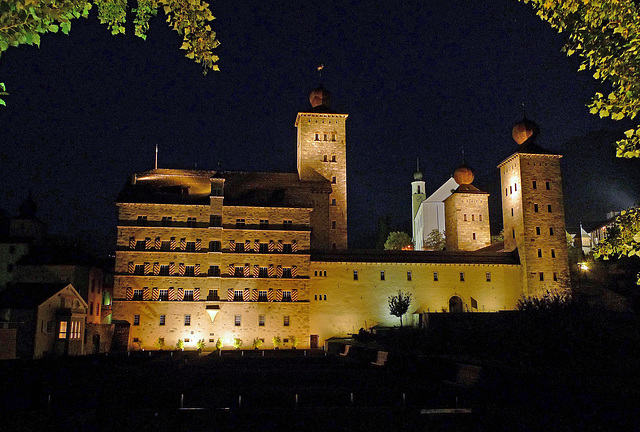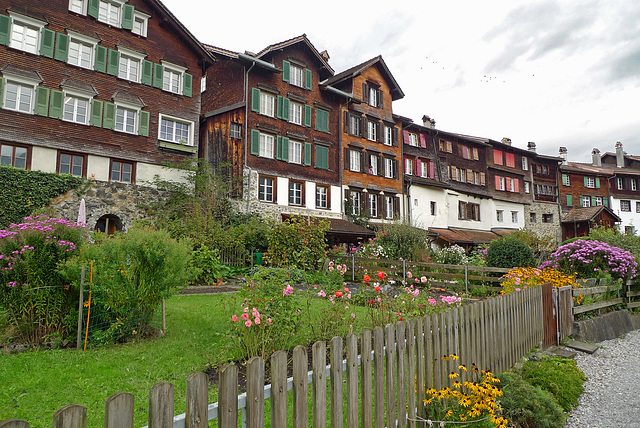
Schweiz - Suisse - Svizzera - Svizra
Switzerland - Basel Minster
The Basel Minster ( Basler Münster ) is a medieval cathedral, situated on a twenty metres high hill high above the river Rhine. The Romans already had a fortress on this hill. The bishopric of Basel was founded in 343, with a residence in Augusta Raurica. In the early middle ages the bishop moved to Basel and the place served as temporary residence of the German kings, which was (and is) called Pfalz (PiP5), offering wonderful views over the Rhine.
Basel's first cathedral was built by bishop Haito (805-823). A larger church, named Heinrichsmünster after German king Heinrich II, was consecrated in 1019. Towards the end of the 11th century a tower on the west side was added - which is still part of today's Georgsturm . A new church building was erected between 1220 and 1230, but almost completely destroyed, due to an earthquake and fire in 1356.
This building was restored using basically the same ground plan, but with some Gothic style elements and consecrated in 1363. Attached to the church is a former monastery with two cloisters (PiP4). During the 16th century reformation the monastery was closed and the bishop expelled from the city.
The building as it stands today dates back for the most part to the late Romanesque building constructed in the last third of the 12th century and completed around 1225. The Basel Minster with its red sandstone architecture (PiP1), impressive interior (PiP2) and beautiful stained glass windows (PiP3) is one of the main landmarks of Basel and still an important tourist attraction.
Switzerland - Saint-Ursanne
Saint-Ursanne is one of the jewels of the Swiss Jura. The medieval town is situated on the banks of the river Doubs at the foot of a rocky mountain ridge.
According to legend, the little town of St-Ursanne was founded at the end of the 6th century by the Irish monk Ursicinus, who lived as a hermit on this isolated spot. His hermitage within a cave can be reached by climbing 180 steep steps. Between 623 and 635 a first monastery community was founded. Around 1100 it was converted into a canons chapter.
Saint-Ursanne has conserved its medieval character (PiP1). Among the most important buildings in the centre are the collegiate church and its cloister (PiP4) built in the 12th and 13th centuries. Other parts of the old town contain heritage buildings dating from the 17th and 18th centuries. Even today, the town can only be accessed through one of the three historic gates. The ‘Porte Saint-Pierre’ is decorated with ‘La Berbatte’ (PiP3), a clock installed early in the 18th century.
The four-arched stone bridge (PiP2) over the river, built in 1728, awards a particularly splendid view of the picturesque town and its environs. A sandstone statue made in 1729 of St. John of Nepomuk, a protector against floods, stands on the bridge.
15 Sep 2017
106 favorites
88 comments
Switzerland - Schaffhausen, Rhine Falls
The Rhine Falls is one of the most impressive and powerful waterfalls in Europe. The falls have a width of 150 meters and are ‘just’ 23 meters high. The capacity of flow is in summer about 600.000 liters per second and in winter about 250.000 liters.
The Rhine Falls were formed 15.000 years ago - in the last ice age - by erosion-resistant rocks narrowing the riverbed, forcing the Rhine River into a new riverbed.
The Rhine Falls Rock ( Rheinfall Felsen ) - a mighty rock in the midst of the falls - offers one of the most spectacular views. This rock can be reached by boat.
Switzerland - Chillon Castle
The medieval Chillon Castle - located on a small rock island - on the shores of Lake Geneva near Montreux is considered being the most visited monument in Switzerland. The current castle is the result of several centuries of building, adaptations, renovations and restorations.
The first written mention of the castle appears in 1150. At that time, the Counts of Savoy controlled the castle, as well as the path between the lake and the mountains, which gave them a strategic location on the route leading from the north to the south. In the 13th century, the Counts furthered their conquests of the territory of Vaud until their domination was extended over approximately two-thirds of the territory, which makes up today’s French-speaking Switzerland. Chillon Castle was extended at that time and was transformed it into a summer residence for the Counts.
The Swiss, or more precisely, the Bernese, conquered the Pays de Vaud. The conquest was completed once they took-over Chillon Castle in 1536 after a three-week siege. For more than 260 years, the castle retained its role as a fortress, arsenal, and prison.
At the time of the Vaudois Revolution, the Bernese left the castle and the patriots of Vevey and Montreux occupied the fortress in January 1798. The castle became national property during the Vaudois Revolution and belongs since then to the Canton of Vaud, from the date of its foundation in 1803. Ther building was first used to stock weapons and ammunitions and as a State prison.
At the end of the 19th century a major restoration campaign was launched, which is still ongoing. The castle is open for visits and tours.
Switzerland - Thun
Thun is a medieval city, located on the west end of Lake Thun. Already as early as 2.500 BC a first settlement arose on today's site of the city. The castle - towering above the old town - was built by the Dukes of Zähringen. It has a donjon (PiP 1), dating back between 1180 and 1190. One can enjoy wonderful views over the city (PiP 2) and the mighty mountains of the Bernese Highlands, with the Eiger, Mönch and Jungfrau in the far distance.
Five bridges connect the modern shopping area of Thun with the medieval city center. By far the most interesting is the wooden covered bridge Untere Schleuse (main picture), built in 1724. The flood gates regulate the water flow of the River Aare (PiP3).
Switzerland - Saint Ursanne, Collégiale
Saint-Ursanne (see: www.ipernity.com/doc/294067/47356382 ) is a charming old town on the banks of the river Doubs, considered being one of the most beautiful villages in Switzerland with its medieval architecture.
The most important monument is the Collégiale with the adjacent monastery. This collegiate church was built at the end of the 12th century with clear Burgundian influences. The architectural style shows elements that point to the transition from the late Romanesque to the early Gothic period. Construction of the choir, the apse and the crypt was finished before 1210. The inside of the church was altered significantly in the 14th century. Major decorative work in the baroque style was undertaken between 1660 and 1702.
The church has a richly decorated gate, most probably from the second half of the 12th century. The semicircular tympanum (PiP1) shows a figure of Christ sitting on a throne; at his right hand praying Saint Ursicinus, the founder of Saint Ursanne.
The cloister (PiP2) is situated to the northwest of the collegiate church. It was constructed and enlarged in 1380 on the existing foundations and later underwent two restorations in 1551 and 1906. It has a series of arcades with so called ogive windows.
Switzerland - Brig, Stockalper Palace
The famous landmark Stockalper Palace (Stockalperschloss) dominates the city of Brig with its monumental architecture. It took twenty years (1658 – 1678) to built this monumental castle with its baroque architecture. The palace was the largest private building of the 17th century in the country. It was built by Kaspar Jodok von Stockalper, a renowned wealthy merchant, banker, entrepreneur, military official and politician.
The palace was built next to the smaller 16th century Stockalper House. It is a rectangular building with three towers with gilded onion domes, named after the Three Kings or Wise Men of the Bible: Caspar, Melchior and Balthazar. The building has a large rectangular courtyard with arcades in the style of the Italian Renaissance, nowadays often used for cultural events.
In 1948 the city of Brig took over the palace and in 1960 the city council moved in. A museum was established and some of the rooms were renovated. Today the palace can be visited with a guided tour.
Switzerland - Werdenberg
Werdenberg - located in the canton of St. Gallen in northeastern Switzerland - was first mentioned in a document dated 1289. Originally it was a fortified town and one of only a few to be granted market rights. It is the only wooden medieval settlement in Switzerland to have retained its town-like character.
Werdenberg has around forty houses which have remained unharmed by major fires. The medieval timber-frame settlement exhibits an extraordinary variety of building designs. Vertical timbered and half-timbered buildings, along with squared log cabins can be found there. Walking in the ‘city’ it looks more like an open air museum, although it is still inhabited and most of the houses are privately owned. With less than hundred inhabitants it is most probably the smallest city in Switzerland.
The town is dominated by Castle Werdenberg on a top of a hill (PiP1), which has a museum. A second regional museum is housed in the so called Schlangenhaus (Snake House) in the settlement itself (PiP2).
Jump to top
RSS feed- Latest items - Subscribe to the latest items added to this album
- ipernity © 2007-2024
- Help & Contact
|
Club news
|
About ipernity
|
History |
ipernity Club & Prices |
Guide of good conduct
Donate | Group guidelines | Privacy policy | Terms of use | Statutes | In memoria -
Facebook
Twitter

